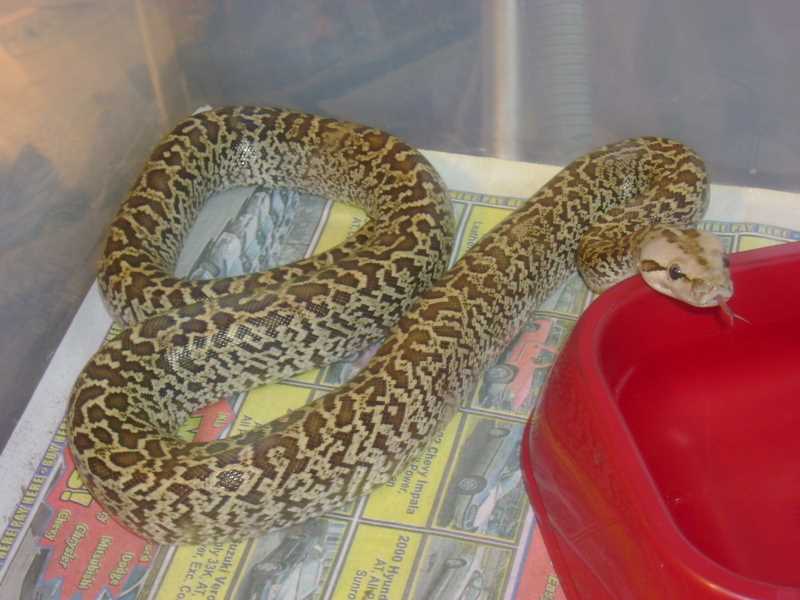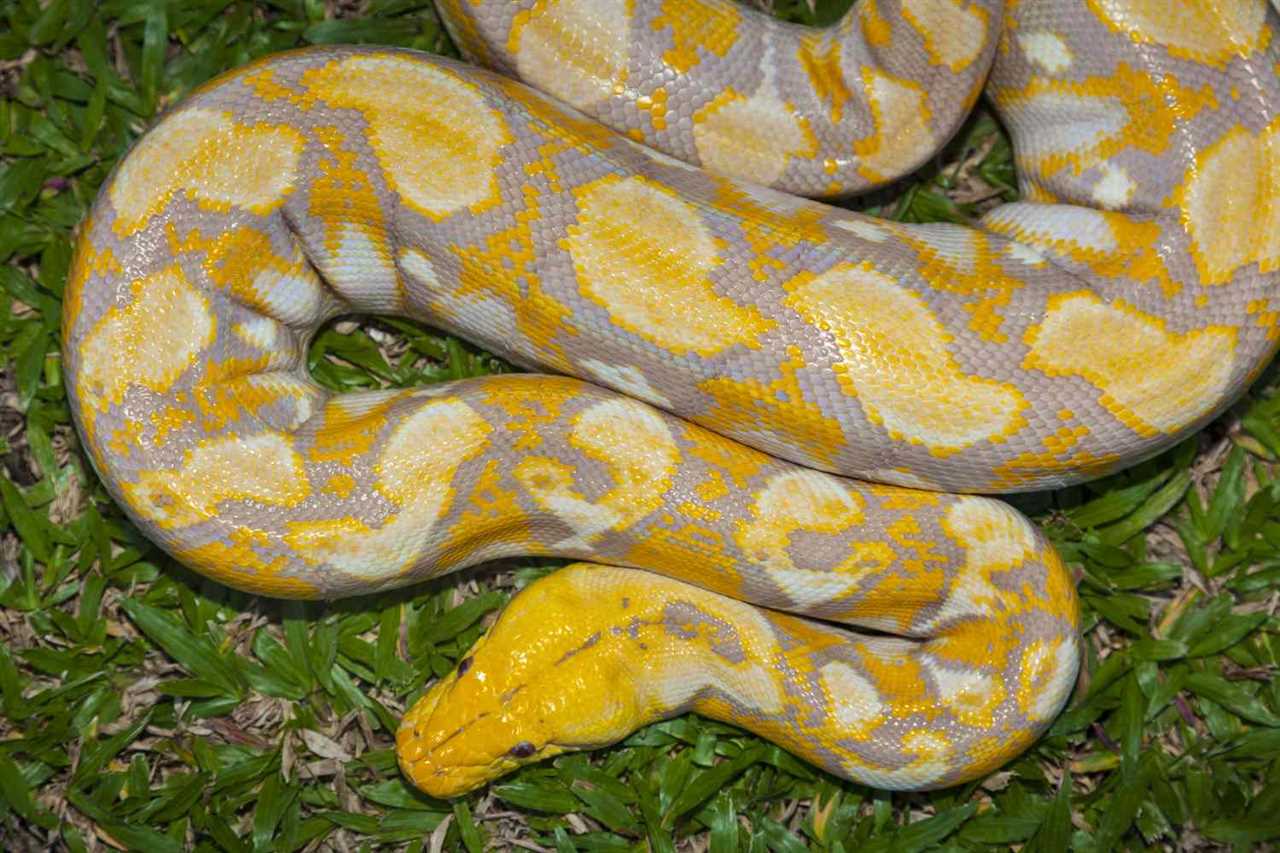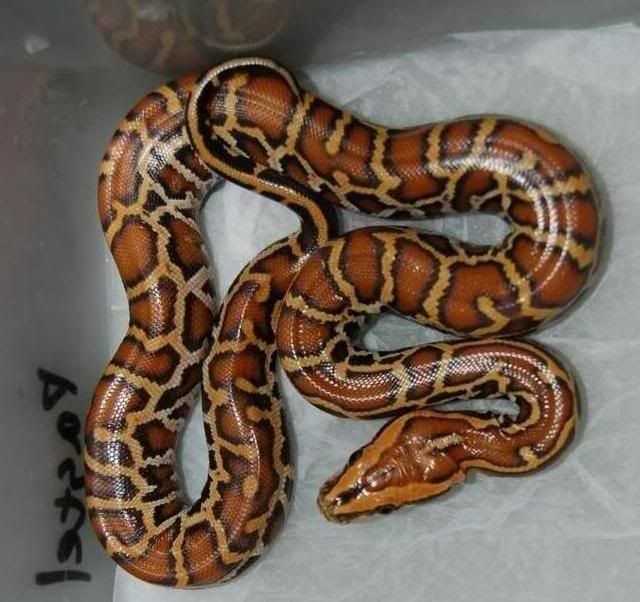One of the most breathtaking features of the Burmese Python morphs is the diverse range of color patterns they exhibit. From vibrant oranges and deep reds to stunning yellows and rich browns, these snakes showcase a mesmerizing palette of colors. The scale patterns vary as well, ranging from intricate mosaics to bold stripes and contrasting blotches.
Each morph of the Burmese Python possesses its own unique combination of colors and patterns, making them highly sought after by snake enthusiasts and collectors. Some popular morphs include the Albino, which lacks any pigmentation and displays a stunning white and yellow coloration; the Piebald, characterized by its large areas of white and irregular patches of color; and the Tiger, featuring bold, dark stripes against a lighter background.
What are Burmese Pythons?
Burmese pythons are large constrictor snakes native to Southeast Asia. They are highly sought after in the reptile pet trade due to their impressive size, docile temperament, and beautiful color patterns. These snakes can grow up to 20 feet in length and weigh over 200 pounds, making them one of the largest snake species in the world.
One of the most fascinating aspects of Burmese pythons is their wide variety of morphs, which are genetic variations that result in different colors, patterns, and physical characteristics. These morphs make each Burmese python unique and highly prized among reptile enthusiasts.
Morphs in Burmese Pythons
Morphs refer to the different color and pattern variations that can occur in a species. In the case of Burmese pythons, there are countless morphs, ranging from subtle variations in color to dramatic patterns and markings.
Some common morphs in Burmese pythons include albino, which lacks the pigment melanin and appears white with yellow markings; caramel, which has a light brown coloration; and granite, which has a speckled or mottled pattern.
Unique and Rare Morphs in Burmese Pythons
While there are numerous popular morphs in the Burmese python world, there are also some unique and rare morphs that are highly sought after by collectors and breeders. These morphs may have unusual color combinations, patterns, or physical characteristics that set them apart from the more common morphs.
For example, the piebald morph has large patches of white and normal coloration, creating a striking contrast. The lavender morph has a pale purple coloration, while the ghost morph has a light gray color and reduced black markings. These unique morphs add diversity and excitement to the world of Burmese python breeding and collecting.
Genetics and Breeding of Burmese Python Morphs
The wide variety of morphs in Burmese pythons is the result of selective breeding and genetic mutations. Breeders carefully pair snakes to produce offspring with desired traits, and over time, this process has resulted in a multitude of morphs.
Caring for Burmese Python Morphs: Tips and Considerations
Additionally, it is crucial to understand the specific needs and potential health issues associated with each morph. Some morphs, such as albinos, can be more sensitive to light and require extra protection from UV radiation. By educating themselves and seeking advice from experienced keepers, owners can ensure the well-being and longevity of their Burmese python morphs.
| Morph | Description |
|---|---|
| Albino | White with yellow markings due to lack of melanin |
| Caramel | Light brown coloration |
| Granite | Speckled or mottled pattern |
| Piebald | Large patches of white and normal coloration |
| Lavender | Pale purple coloration |
| Ghost | Light gray color with reduced black markings |
Burmese pythons are a species of large constrictor snake known for their impressive size and distinctive scales. These reptiles can grow up to 23 feet long and weigh over 200 pounds. One of the fascinating aspects of Burmese pythons is the wide variety of morphs or color patterns that can occur in their scales.
Morphs in Burmese pythons refer to the different genetic variations that result in unique scale patterns and colors. These variations can range from subtle differences in shade to striking and vibrant combinations of colors. Each morph in Burmese pythons is produced through selective breeding, where breeders carefully choose individuals with desired traits to mate and produce offspring with specific characteristics.
One of the most popular morphs in the Burmese python world is the albino morph. Albino pythons lack the dark pigment called melanin in their scales, resulting in a pale, creamy coloration with reddish or orange tones. This morph is highly sought after by reptile enthusiasts due to its striking appearance.
The Pattern Morphs
Another fascinating group of morphs in Burmese pythons are those that affect the scale pattern. Some individuals may have patterns that are reduced or completely absent, resulting in a solid-colored snake with hardly any visible markings. These morphs are often referred to as patternless or reduced pattern morphs.
On the other hand, there are morphs that enhance the scale pattern, creating intricate and unique designs. These pattern morphs can include variations such as stripes, spots, or blotches. One example is the tiger morph, which has bold and dark stripes that run the length of the snake’s body.
The Combination Morphs

In addition to color and pattern variations, some Burmese pythons exhibit combination morphs. These morphs incorporate multiple traits, resulting in snakes with truly one-of-a-kind appearances. For example, a snake could have both an albino coloration and a pattern morph, creating a visually stunning and rare combination.
Popular Morphs in the Burmese Python World
One of the most well-known morphs is the Albino Burmese Python. These snakes have a lack of pigmentation, resulting in their stunning white coloration. Their eyes are typically red or pink, creating a mesmerizing contrast against their pale scales. The Albino morph has been popular in the pet trade for its striking beauty.
Another sought-after morph is the Piebald Burmese Python. These snakes have a unique pattern of large irregular patches of white on a background of varying shades of brown or black. The Piebald morph is highly valued for its eye-catching, mosaic-like appearance, which is a result of specific genetic mutations.
The Burmese Python world also includes the Granite morph, which showcases a pattern that resembles the granite rock. These pythons have a mix of light and dark scales in a mottled pattern, giving them a textured and rugged appearance. The Granite morph is highly sought-after for its unique and distinct scale pattern.
One more notable morph is the Green Burmese Python. These pythons exhibit a vibrant green coloration instead of the typical brown or black. The Green morph is achieved through selective breeding and has become highly popular for its unusual and striking appearance.
Conclusion

These are just a few examples of the popular morphs found in the world of Burmese pythons. Snake enthusiasts are continuously striving to create and discover new morphs, resulting in an ever-growing collection of unique and rare variations. Whether it’s the mesmerizing Albino, striking Piebald, rugged Granite, or vibrant Green, each morph offers a fascinating glimpse into the beauty of these magnificent reptiles.
Unique and Rare Morphs in Burmese Pythons

Albino Burmese Pythons
One of the most sought-after morphs in the world of Burmese Pythons is the albino morph. Albino pythons lack melanin, the dark pigment that gives snakes their typical coloration. This absence of melanin results in a stunning white or creamy appearance with pink or red eyes. The albino morph is highly desirable due to its striking beauty and rarity.
Pattern and Color Variations
Burmese Pythons come in a variety of unique pattern and color variations, making them even more fascinating to snake enthusiasts. Some morphs display stunning patterns, such as stripes or intricate mazes, while others showcase vibrant colors, including bright oranges, deep greens, and vivid yellows. Each pattern and color variation is a result of specific genetic traits and breeding.
For example, the caramel Burmese Python morph is known for its beautiful caramel-colored scales, while the granite morph presents a mesmerizing speckled pattern that resembles the texture of granite rock. These distinctive patterns and colors make each morph truly one-of-a-kind.
Scale Variations
In addition to unique patterns and colors, some Burmese Python morphs also exhibit scale variations, adding an extra layer of intrigue. The scale pattern can vary from smooth and shiny to rough and textured, creating visually stunning snakes that are unlike any other. These scale variations contribute to the overall appearance and individuality of each morph.
Whether it’s the smooth and glossy scales of the pearl Burmese Python or the rough and textured scales of the diamond morph, these scale variations make these reptiles even more captivating and extraordinary.
The world of morphs in Burmese Pythons is truly awe-inspiring. With albino snakes showcasing their beautiful lack of melanin, pattern and color variations adding a burst of uniqueness, and scale variations creating a visually stunning effect, these morphs are a testament to the incredible diversity and beauty of the reptile world.
Genetics and Breeding of Burmese Python Morphs
The Basics of Burmese Python Genetics
Unlike humans, who have 46 chromosomes, Burmese pythons have 36 chromosomes. This makes their genetics quite different from ours. In addition, they exhibit co-dominance, meaning that traits from both parents can be expressed in the offspring.
The Role of Genes in Burmese Python Morphs
When breeding Burmese pythons, breeders can use these genes to produce specific morphs. By selectively choosing snakes with desired traits and breeding them together, breeders can create offspring with unique patterns and colors. This process requires careful documentation and tracking of the snake’s lineage to ensure the desired traits are passed down.
The Complexity of Burmese Python Breeding
While breeding Burmese pythons may seem straightforward, it is actually quite complex. In addition to the different genes and traits that can be combined, there are also factors such as temperature and incubation time that can affect the outcome of breeding. For example, some morphs may only develop their full coloration if they are incubated at a certain temperature.
Furthermore, breeding Burmese pythons requires careful consideration of ethical and conservation concerns. Due to their popularity in the exotic pet trade, there is a risk of overbreeding and depleting wild populations. Responsible breeders must ensure they are breeding for the right reasons and maintaining the health and well-being of the snakes.
The Future of Burmese Python Morphs
The world of Burmese python morphs is constantly evolving, with new and unique patterns being discovered and bred. As breeders continue to experiment and refine their techniques, we can expect to see even more stunning and unusual morphs in the future. However, it is crucial that this is done responsibly, with a focus on conservation and sustainable breeding practices.
Caring for Burmese Python Morphs: Tips and Considerations
Habitat and Enclosure
The first step in caring for a Burmese python morph is to provide it with an appropriate habitat. A spacious enclosure is necessary to accommodate the snake’s size as it grows. The enclosure should be escape-proof, with secure and sturdy locks.
Inside the enclosure, provide a range of artificial climbing branches and hiding spots. Burmese pythons are strong climbers and require a vertically-oriented environment. The substrate can consist of aspen shavings or cypress mulch, which provide a natural and comfortable bedding for the snake.
Temperature and Humidity
Temperature is a crucial aspect of Burmese python care. These snakes are ectothermic, meaning they rely on external heat sources to regulate their body temperature. Maintain a thermal gradient in the enclosure, with a warm side and a cooler side. The warm side should be around 85-90°F (29-32°C), while the cooler side can be around 75-80°F (24-27°C).
Diet and Feeding
Handling and Enrichment
Enrichment is also essential for the snake’s overall well-being. Provide the snake with mental and physical stimulation through the use of hiding spots, climbing opportunities, and novel objects within the enclosure. This helps prevent boredom and promotes natural behaviors.

I’m Lena Adams—a product of an unconventional upbringing in the African wilderness. My father, a daring explorer of African wildlife, sparked my fascination with reptiles, a passion that intertwined with the tragic loss of my mother during an expedition, leaving an indelible mark on my life. Driven to understand the creatures that captivated my parents, I embarked on my journey, sharing insights about reptiles, frogs, and lizards on my website. Through my explorations and conservation efforts, I honour my family’s legacy while seeking connections—to the creatures, nature, and the mother whose presence I yearn to understand.
